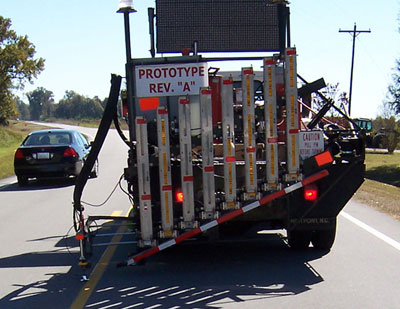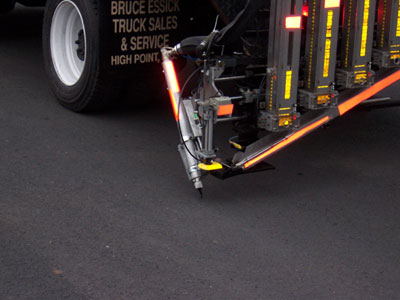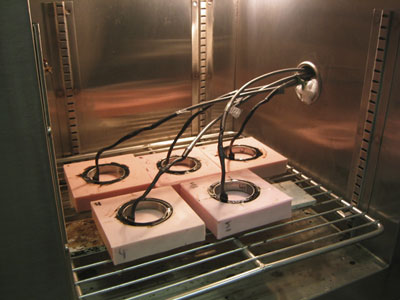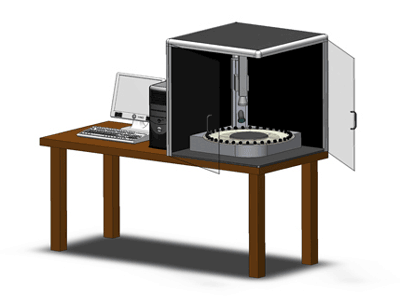U.S. Department of Transportation
Federal Highway Administration
1200 New Jersey Avenue, SE
Washington, DC 20590
202-366-4000
Focus
| Accelerating Infrastructure Innovations |
Publication Number: FHWA-HRT-08-010
Date: January/February 2008
To accelerate the adoption of innovations aimed at reducing congestion and improving highway quality and safety, the Federal Highway Administration's (FHWA) Highways for LIFE (HfL) program has awarded five grants under its Technology Partnerships Program. The program is designed to help companies refine and further develop technologies in partnership with State departments of transportation and local transportation agencies.
The Technology Partnerships Program received 55 proposals for grants, representing the first time FHWA has awarded grants directly to general industry. "The high number of proposals illustrates that there are many companies advancing ideas that hold great promise for improving our roads and bridges," says King W. Gee, FHWA Associate Administrator for Infrastructure. "The Technology Partnerships Program is designed to move these innovations closer to market more quickly."
| "The high number of proposals illustrates that there are many companies advancing ideas that hold great promise for improving our roads and bridges." |
The All-Weather Pavement Marking System developed by the 3M Company was awarded $499,277, which will be used to adapt the product for cost-effective temporary use in work zones. The system incorporates wet-reflective optical elements into a specially designed pavement marking paint to make it easier for drivers to see markings on wet roads. This is particularly important in work zones, where motorists often encounter new and unfamiliar traffic patterns. "We're looking at how to best refine the product so that it can be applied in work zones, including experimenting with different variations of the product to optimize visibility and durability," says Fuat Aktan of 3M Company. A set of initial candidate samples are currently being evaluated on a test section in New Orleans, Louisiana, to be followed by visibility and human-factor experiments on a few refined samples at the Texas Transportation Institute in College Station, Texas. In the second phase of the project, the final product will be evaluated in real-world work zones.
Haskell Lemon Construction Company was awarded $200,000 for its Intelligent Asphalt Compaction Analyzer project. The analyzer was designed to address the problem of improper or inadequate compaction, which is a leading cause of early degradation of asphalt pavements. Mounted on a vibratory compactor, the device continuously senses the amplitude and frequency of the compactor's vibrations and estimates the pavement's compacted density during each roller pass. This real-time feedback allow compaction inconsistencies to be identified and remedied during the paving process, resulting in reduced construction time, reduced labor and fuel costs, and longer-lasting pavements. "The end result will be a better quality pavement," says the technical lead for the project, Sesh Commuri of the University of Oklahoma.
The Asphalt Binder Cracking Device developed by EZ Asphalt Technology, LLC, received a grant of $239,386. This test device induces thermal stresses in an asphalt binder at very low temperatures up to the point of fracture. By simulating cracking in the field, this simple test can help agencies predict and prevent asphalt failure caused by cracking at low temperatures, helping to reduce the need for repair and extending the life of pavements.
Improved work zone safety is a key advantage of the Automated Roadway Pavement Marker Placement System, which received $451,660. Developed by Stay Alert Safety Services, Inc., the device automates the process of installing raised reflective pavement markers. Initial tests have shown that the system reduces construction time and the resulting congestion, as well as the risk of worker injury.
 |
| The Automated Roadway Pavement Marker Placement System speeds up the process of installing raised reflective pavement markers. |
 |
| The All-Weather Pavement Marking System makes it easier for drivers to see markings on wet roads. |
 |
| A close-up of the Automated Roadway Pavement Marker Placement System. |
The Aggregate Imaging Measurement System developed by Pine Instrument Company was awarded a grant of $200,000. The system combines hardware that captures real-time digital images of paving material samples with software that can analyze the shape, texture, angularity, and ratio characteristics of aggregates. The analysis can be performed for both hot-mix asphalt and hydraulic cement concrete. "It both captures the image and analyzes the aggregate," says Dave Savage of Pine Instrument Company. The system replaces existing manual techniques for examining aggregates that are time-consuming and subjective, providing more rapid measurement and enhanced information on the aggregate material properties to help improve pavement performance. The grant will be used to further develop the system into a ready-to-use product. The Texas Department of Transportation is partnering with Pine on the project and will test the system this year.
For more information on the Technology Partnerships Program or to participate in the testing and evaluation of the funded projects, contact Julie Zirlin at FHWA, 202-366-9105 (email: julie.zirlin@fhwa.dot.gov). For contacts for each project, see sidebar. To receive additional information and updates on the projects, register at www.fhwa.dot.gov/hfl/tech.cfm.
Technology Partnerships Program ContactsAll-Weather Pavement Marking System, Fuat Aktan, 3M Company, 651-733-5041 (email: faktan@mmm.com). Intelligent Asphalt Compaction Analyzer, Sesh Commuri, University of Oklahoma, 405-325-4302 (email: scommuri@ou.edu). Asphalt Binder Cracking Device, Sangsoo Kim, Ohio University, 740-593-1463 (email: kim@ohio.edu). Automated Roadway Pavement Marker Placement System, Jim Babcock, Stay Alert Safety Services, Inc., 336-993-2828 (email: jbabcock@stayalertsafety.com). Aggregate Imaging Measurement System, Dave Savage, Pine Instrument Company, 724-458-6391 (email: dsavage@pineinst.com). |
 |
| The Asphalt Binder Cracking Device simulates cracking in the field to help agencies predict and prevent asphalt failure caused by cracking at low temperatures. |
 |
| Enhanced information on aggregate material properties will be provided by the Aggregate Imaging Measurement System. |